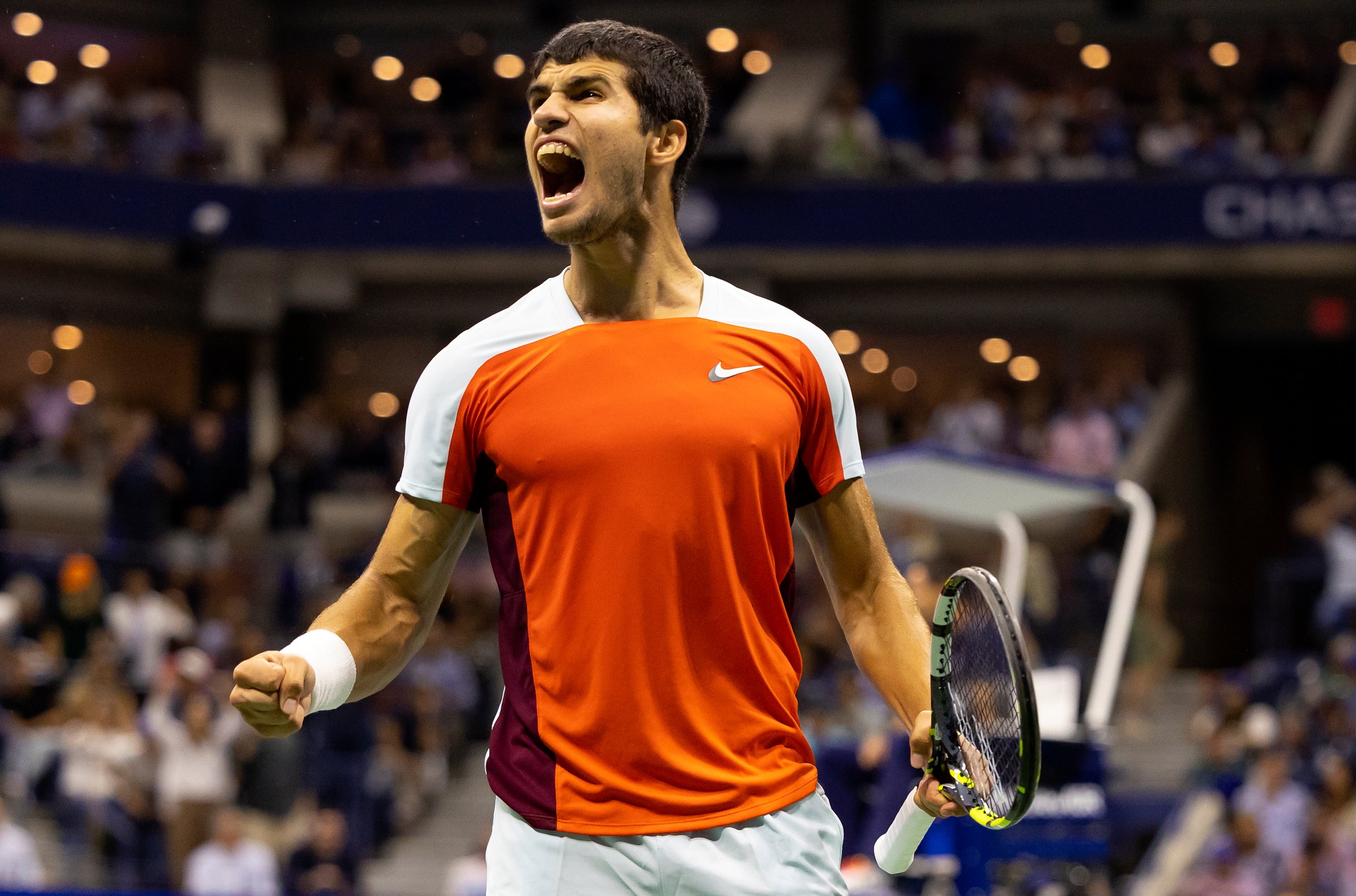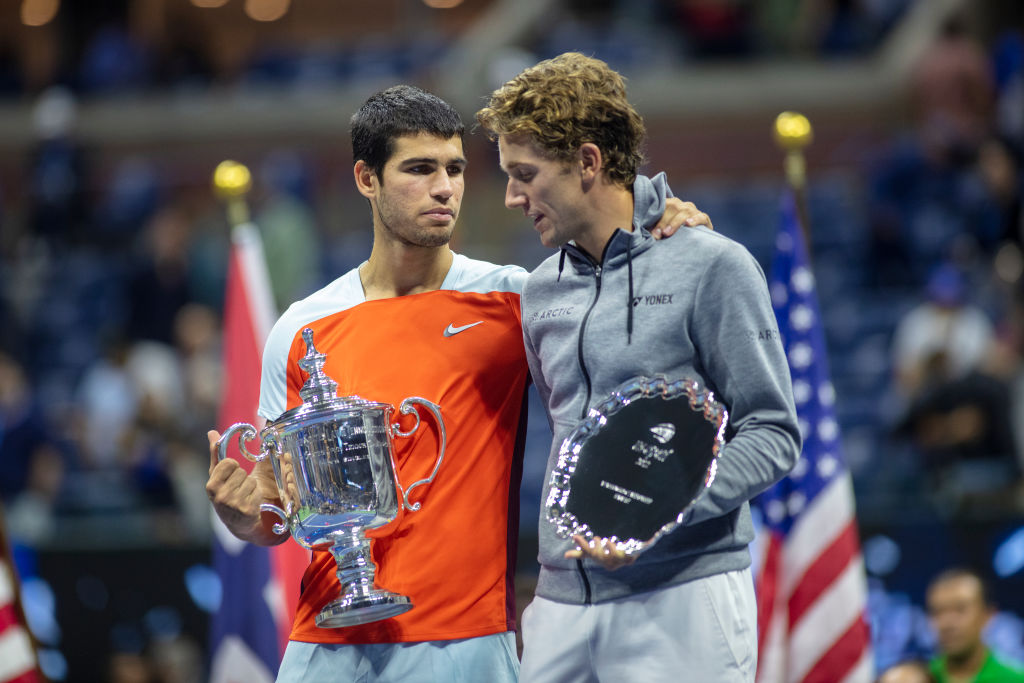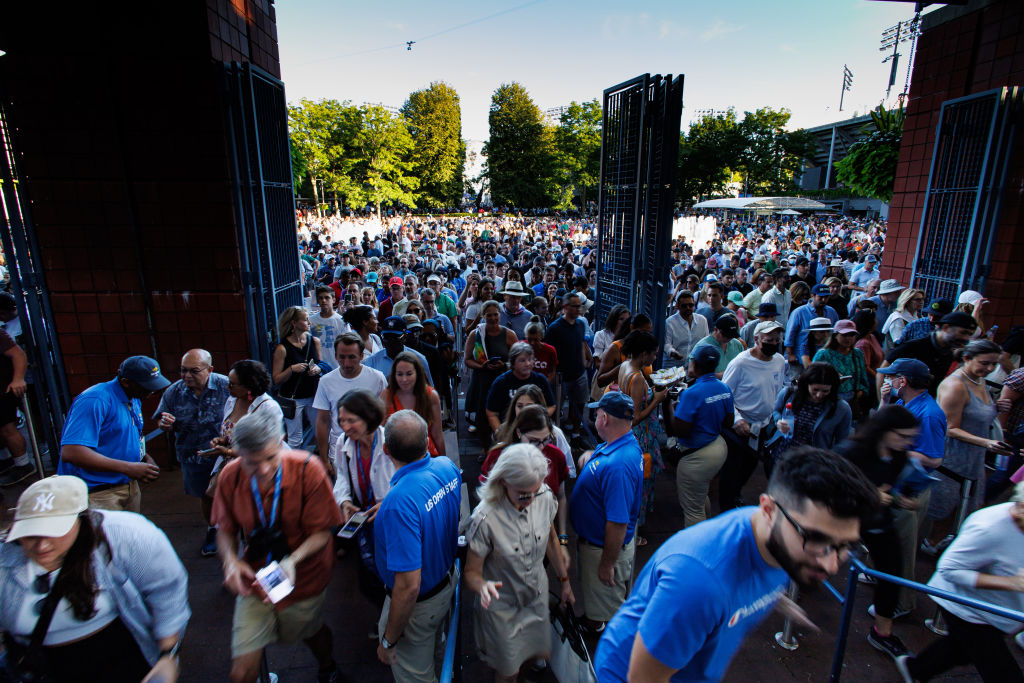
To be a top athlete, you have to do more than just play to your strengths. Sometimes, especially when under pressure, you need to draw on a overlooked part of your game.
Take 19-year-old Carlos Alcaraz. He beat Casper Ruud of Norway 6-4, 2-6, 7-6 (1), 6-3 on Sunday night at the 2022 U.S. Open to win his first major championship—and become the youngest-ever No. 1 men’s tennis player in the world.
The Spaniard is known for his ability to move around the court, chasing down balls, and for the variety and angles of his shots, from drop shots to lobs. Although he has a decent serve—you don’t ascend the summit without one—he isn’t known for serving.
But, displaying the true mark of a champion, Alcaraz used his serve to wrestle control of the championship on Sunday night, when Ruud, 23, put himself in position to break Alcaraz late in the match. It was if the younger man was drawing on some hidden power.
Having already passed the record for most time spent on the court during a US Open—23 hours and 20 minutes in all his matches—Alcaraz must have been tired. He was up 4-3 in the fourth set, but down 0-30 in the game. After smacking a forehand winner to make it 15-30, Alcaraz unfurled a 123 mile-per-hour ace right up the T, than another one wide of Ruud’s forehand, to go up in the game, and eventually hold. He was now one game away from the title.
Read More: Frances Tiafoe Might Save American Men’s Tennis
Serving for the championship moments later, he found two more aces, before rocketing a 125 miles-per-hour service winner to end it all. He splayed his body on the court, before rolling over to shed tears of pure joy.
“It’s tough to talk right now,” he said in his on-court interview after the match. Was he finally exhausted? “A little bit,” he said, smiling.
More from TIME
Even on a night when his signature drop shot wasn’t as sharp as it was in his semi-final win against American Frances Tiafoe on Friday night, Alcaraz gutted it out. He and Ruud played several exciting points at the net, trying to pop balls past each other up close, as if locked in a game of pickleball. Rudd won a few, Alcaraz won a few.
But Alcaraz scored the big ones. After Ruud crushed Alcaraz 6-2 in the second set to even up the match, Alcaraz served to force a third-set tiebreaker. Dropping this set would have given Ruud all the momentum. Ruud got to set point; Alcaraz saved it with a cross-court forehand near the net. He saved a second set point with an aggressive smash at the net.
Finally, on the 16th point of the game, Alcaraz send Rudd scrambling. Rudd ran after an Alcaraz lob and smacked the ball between his legs, over the net. But an imposing Alcaraz was waiting to blast Rudd’s trick shot back past him. Alcaraz waved both arms up in the air to rally the sellout crowd. Ruud collapsed in the tie-breaker, winning just a single point.

The new global stars of tennis
This was a transitional U.S. Open. With Novak Djokovic absent due to his refusal to receive the COVID-19 vaccine, Rafael Nadal being bounced in the fourth round, Roger Federer still nursing an injury and Serena Williams losing in the third round of what she has declared to be her final tennis tournament, we got a glimpse of the sport’s future. There’s plenty of talent, from many corners of the globe.
In women’s tennis, Poland’s Iga Swiatek, 21, took two Grand Slams—the French Open and the U.S. Open—to emerge as a dominant force. She became the first woman since Angelique Kerber in 2016 to win two majors in the same calendar year.
Ons Jabeur of Tunisia, 28, became the first Arab and first African woman to make a Grand Slam final in the Open Era, as she reached championship matches at Wimbledon and the U.S. Open. She’s known as the “Minister of Happiness” in her home country, given her sunny disposition.
Read More: The Surprising and Sometimes Troubling History of Tennis Clothes
Meanwhile, 18-year-old American Coco Gauff, now a high school gradate, reached her first Grand Slam final—in Paris—and continues to progress.
On the men’s side, Alcaraz and Italy’s Jannik Sinner, 21, played a 5 hour, 15 minute quarterfinal last Thursday that ended at 2:50am, later than any other match in U.S. Open history. You can expect this dueling to be resumed in the years to come.
Ruud will also be in the mix, having reached a pair of Slam finals this year. So will Nick Kyrgios, 27, who proved that he’s more than just a troublemaker on tour. No matter what you think about his antics, he is appointment viewing—just take a look at his run-up to the Wimbledon final.
Also determined to break through is 24-year-old Frances Tiafoe, who came so close to breaking the 19-year American men’s title drought in the majors.

Tennis’ new generation
Global media is betting on the sport’s next generation. Netflix, for example, has given the green light to a behind-the-scenes series focused on young stars such as Swiatek and Tiafoe. Stakeholders hope the project will grow the game’s audience, much like Drive To Survive did for Formula 1.
Spectators won’t need much convincing. The U.S. Open set a host of attendance records this year. The full three-week figure of 888,044 broke the prior mark, set in 2019. This year was also the first in the Arthur Ashe Stadium’s 25-year history in which each of the 23,859 seats were sold out for every session. Sure, Serena Williams’ last dance was a key driver for such enthusiasm. But so were the younger stars—especially Alcaraz.
He says he started believing he could win a major after winning in Miami, in early April, when he defeated players like Ruud and then-world No. 5 Stefanos Tsitsipas on the way to that prestigious hard-court title.
Read More: What Keeps Ukrainian Tennis Stars Going While War Rages at Home
“I think he born to play this kind of tournament, born to play these kind of matches,” says his coach, former French Open champ Juan Carlos Ferrer. “Since the moment that I started with him, I saw some things that were different than the other guys at his age.”
Around 6:00pm on Saturday, the night before the final, Alcaraz stepped out of a midtown Manhattan hotel with some family, friends, and Ferrero, for a walk in Central Park. He barely went recognized. That may change now that he’s a champion. The world will get a chance to see what kind of stamina Alcaraz has.
“I’m hungry for more,” he said at his post-game press conference, casually attired in blue shorts and a wrinkled white windbreaker. Then he looked over at the championship trophy, with a smile.
“I’m going to fight [to] have more of this,” the youngster said. “I want to be in the top for many, many weeks—[hopefully] many years.”
—with reporting by Ratu Kamlani/New York City
More Must-Reads from TIME
- Inside Elon Musk’s War on Washington
- Meet the 2025 Women of the Year
- Why Do More Young Adults Have Cancer?
- Colman Domingo Leads With Radical Love
- 11 New Books to Read in Februar
- How to Get Better at Doing Things Alone
- Cecily Strong on Goober the Clown
- Column: The Rise of America’s Broligarchy
Write to Sean Gregory at sean.gregory@time.com